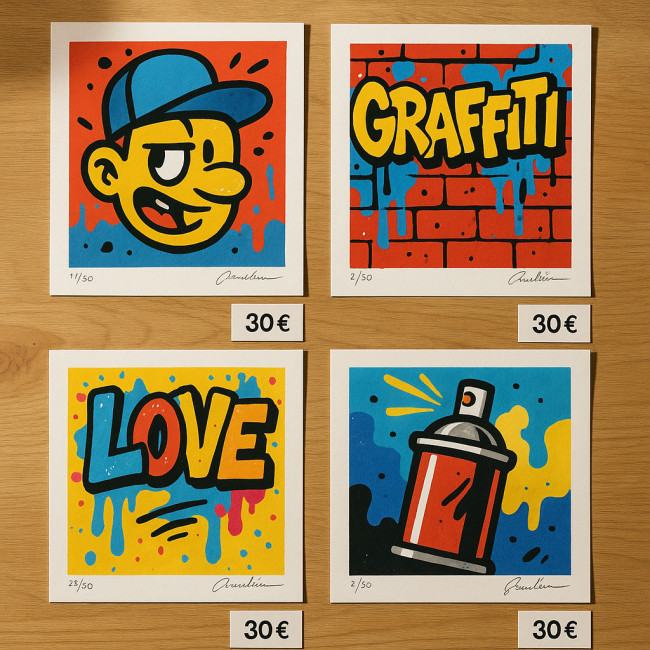From wall to print: turn ephemeral street pieces into a profitable art catalog
Street art disappears fast—washed away by rain, painted over, or buffed by city workers. Converting those ephemeral street pieces from wall to print not only preserves your work, it opens a reliable revenue stream. Follow this step-by-step guide to capture, curate, print, price and promote a profitable art catalog that collectors can own forever.
Why transform street art into prints?
Collectors love the raw energy of murals but rarely buy an actual wall. Limited-edition prints solve that problem while giving you control over quality, scarcity and pricing. A catalog also builds authority, attracts gallery shows and supports future street-artist commission contracts.
- Scarcity drives value: numbered editions create urgency.
- Access for fans worldwide: prints ship where murals cannot.
- Diversified income: balance unpredictable commissions with steady print sales.
Curate your strongest street pieces
Capture high-resolution images on site
Use a 24-megapixel (or higher) camera with a polarizing filter to cut glare. Shoot in RAW at multiple angles before the artwork ages. For large walls, stitch overlapping frames in software like PTGui to maintain detail.
Select a coherent series
Your catalog should read like a story, not a random scrapbook. Group works by theme, color palette or neighborhood. A tight narrative raises perceived value and simplifies marketing.
Secure rights and permits
If the mural is on private property, confirm print reproduction rights in writing. For public walls, check local regulations—guidelines in our article on public art permits help you avoid legal surprises.
Prepare files for flawless printing
Color management matters
Calibrate your monitor, convert files to Adobe RGB, then embed sRGB copies for web previews. Supply printers with a 300-dpi TIFF and an ICC profile to avoid dull reds or crushed blacks.
Choose the right dimensions
A2 or 18”×24” prints balance framing standards with shipping costs. Offer one small “entry-level” size and one large “statement” size to serve different budgets.
Compare printing techniques
| Technique | Pros | Cons | Best for |
|---|---|---|---|
| Giclée (Inkjet) | Vivid color, museum-grade papers | Higher unit cost | Photographic murals |
| Screen print | Graphic textures, handmade feel | Setup time, color limits | Bold line art |
| Risograph | Eco inks, small runs | Color shifting | Zines & experimental palettes |
Price and edition size

Use the 10× rule: charge at least ten times your production cost. For example, a €25 giclée should list at €250. Keep editions under 100 to sustain long-term value. Explore limited-edition print add-ons—artist proofs, embossing or holographic certificates—to justify premium pricing. Providing transparent rationale builds trust and can spark conversation at art fairs or inside your online shop, ultimately reinforcing the perceived value of both the artwork and the story behind each numbered sheet.
Designing a compelling art catalog
Layout tips that convert
Start with a full-bleed hero image, then alternate close-ups and installation shots. Include a short artist statement and technical specs (spray paint, wheat paste, location, year) under each plate. Use recycled 170 g/m² matte paper to echo your urban roots while keeping shipping weight in check.
Create a sense of progression
Arrange works chronologically or by daylight to night pieces. A clear rhythm encourages readers to turn every page—vital when your catalog doubles as your sales pitch.
Sell and distribute your catalog
Direct-to-collector channels
Open pre-orders on your site four weeks before printing. Offer bundle pricing: catalog + signed print + sticker set. For online visibility, list your collection on the Artfolio image-designer marketplace where curators and corporate buyers browse fresh talent.
Gallery and pop-up partnerships
Split revenue 60/40 in your favor when providing framed prints ready to hang. Pop-ups near the original wall attract locals who witnessed the artwork live, turning nostalgia into sales.
Promotion tactics that boost sell-through
- Behind-the-scenes reels: Post 15-second clips of the wall and the printing press.
- Geo-targeted ads: Serve Instagram ads within 5 km of the mural's location for immediate recognition.
- Email countdown: Send three reminders—launch, 72-hour left, and last chance—to your list.
- Press outreach: Offer exclusive images to local culture blogs; coverage often spikes sales by 20 %.
“A limited print run is the only way my Paris mural lives on now that the building's been demolished.” —Street artist Naya
FAQ
- How many prints should my first edition include?
- Start with 50. It keeps costs manageable while creating urgency. You can always launch a new series, but you can't undo oversupply.
- Can I print murals painted on city property?
- Yes, as long as you own the copyright. Verify local bylaws; some cities claim no rights, others require a simple notification.
- What paper weight suits a high-end catalog?
- Between 150 g/m² and 200 g/m² for pages; 300 g/m² for the cover. Heavier stock feels luxurious without inflating postage.
- Do collectors prefer signed prints?
- Absolutely. Hand-signing and numbering can raise perceived value by up to 35 %.
Quick Knowledge Check
Next steps
You now have a roadmap to turn fleeting street pieces into a profitable art catalog. Gather your files, choose a print method and set your pre-order date. Need deeper guidance? Download our free checklist and join the newsletter for print-studio discounts.
Ready to take your art from wall to print? Start curating today and watch your catalog turn fans into lifelong collectors.











